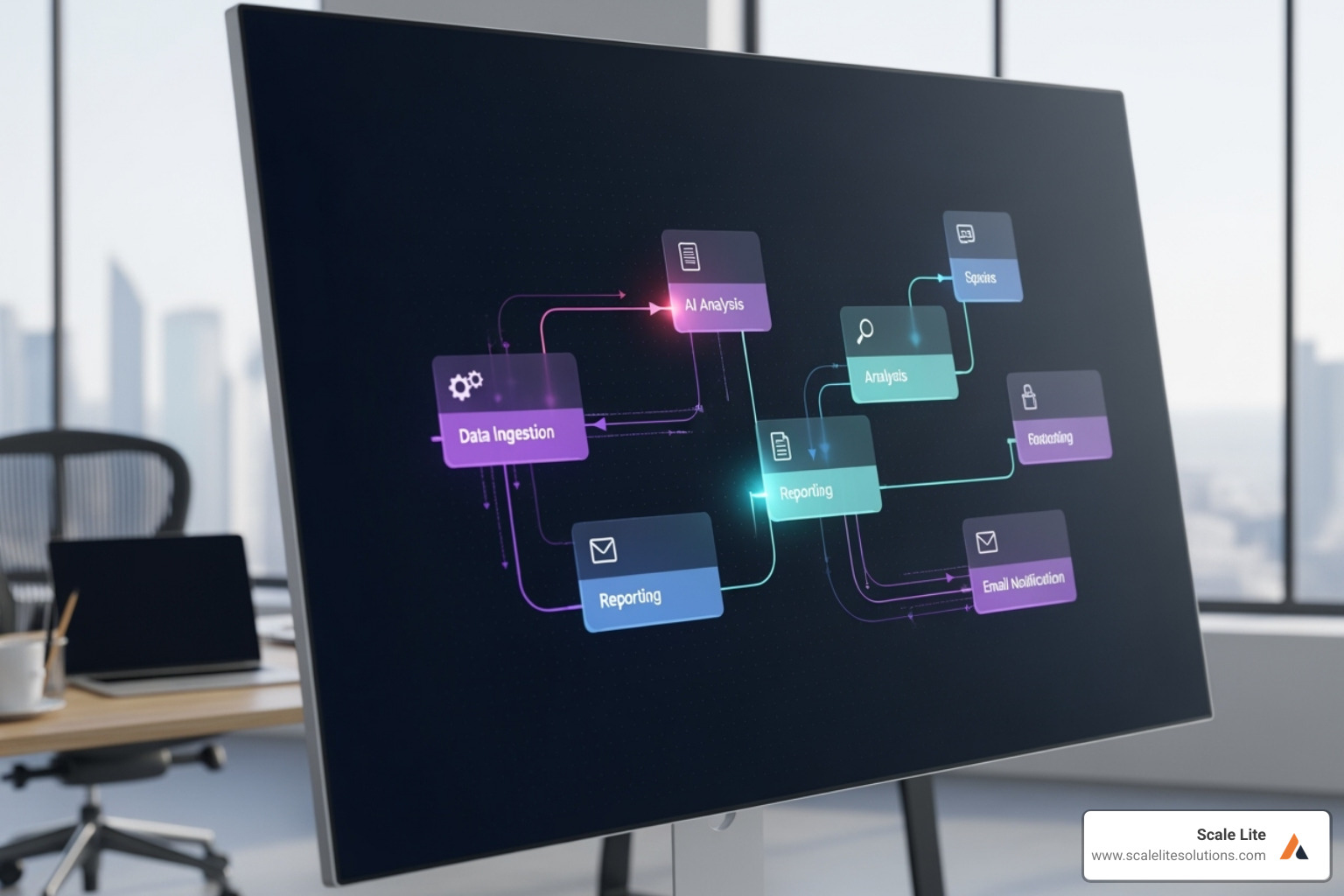
The Efficiency Edge: Driving Gains with AI in Your Business

Why AI-Driven Efficiency Is Changing Modern Business
AI driven efficiency is the practice of using artificial intelligence to automate tasks, optimize processes, and make data-driven decisions that reduce costs while increasing productivity. Here's how it works:
- Process Automation: AI handles repetitive tasks like data entry, scheduling, and invoice processing
- Predictive Analytics: Systems forecast demand, equipment failures, and customer behavior
- Real-Time Optimization: AI continuously adjusts operations based on current conditions
- Improved Decision-Making: Data analysis provides actionable insights faster than manual methods
The numbers speak for themselves. Research from MIT Sloan School shows AI can improve an employee's performance by up to 40%. Meanwhile, businesses implementing AI-powered workflow automation expect a 31% decrease in operational expenses, as reported by Deloitte.
But here's what makes this especially relevant for service businesses: AI isn't just about cutting-edge technology anymore. It's about solving real problems that keep business owners up at night - like responding to customer calls fast enough to win jobs, managing inventory without constant guesswork, or reducing the manual work that eats up your team's time.
The change is already happening. Companies are using AI to handle 70% of customer inquiries automatically, reduce maintenance-related delays by 30%, and cut quality control costs by 50%. For businesses ready to work smarter instead of harder, AI represents the clearest path to sustainable growth and operational excellence.
I'm Keaton Kay, founder of Scale Lite, where I help service businesses implement systems that reduce owner dependence and increase operational efficiency. Through my experience in private equity, enterprise SaaS, and revenue operations, I've seen how AI driven efficiency transforms companies from reactive to strategic, creating scalable value that positions them for growth or successful exit.
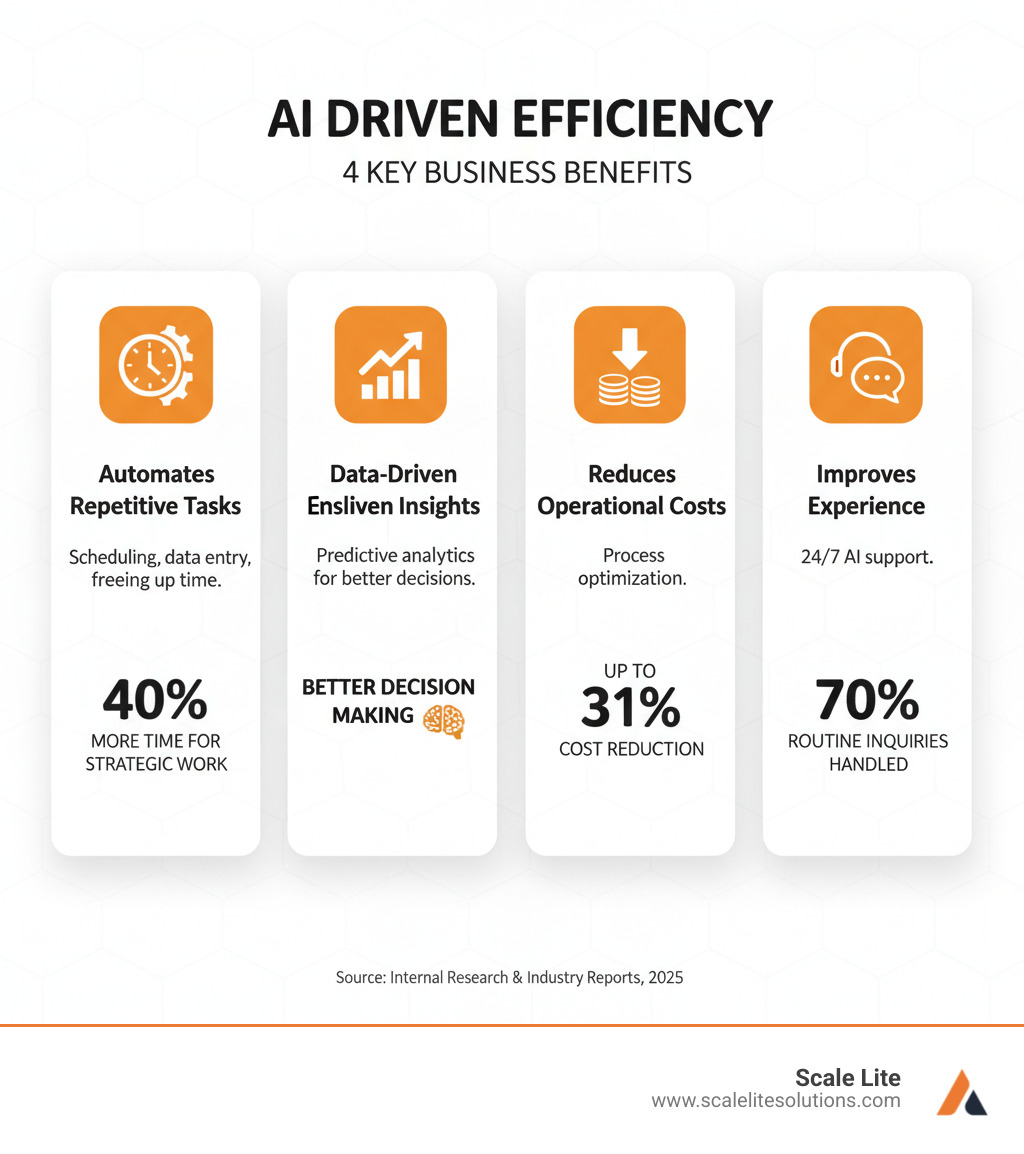
What is AI-Driven Efficiency and How Does It Work?
AI driven efficiency is your business's secret weapon for achieving operational excellence. It's like having a brilliant team member who never gets tired, never misses a detail, and constantly finds better ways to get things done. This approach uses artificial intelligence to streamline your processes, slash unnecessary costs, and open up productivity gains that seemed impossible just a few years ago.
Here's what makes AI different from traditional business methods. While old-school analytics look backward at what already happened, AI looks forward and sideways too. It spots patterns in real-time, predicts what's coming next, and automatically adjusts your operations to stay ahead of problems before they hit your bottom line.
The results speak for themselves. According to MIT Sloan School, AI can improve employee performance by up to 40%. That's not just a small bump – that's the difference between struggling to keep up and leaving your competition in the dust.
The Core Technologies Powering Efficiency
When we talk about AI changing your business, we're really talking about four powerful technologies working together like a well-coordinated team. These aren't sci-fi concepts – they're practical tools you can start using today.
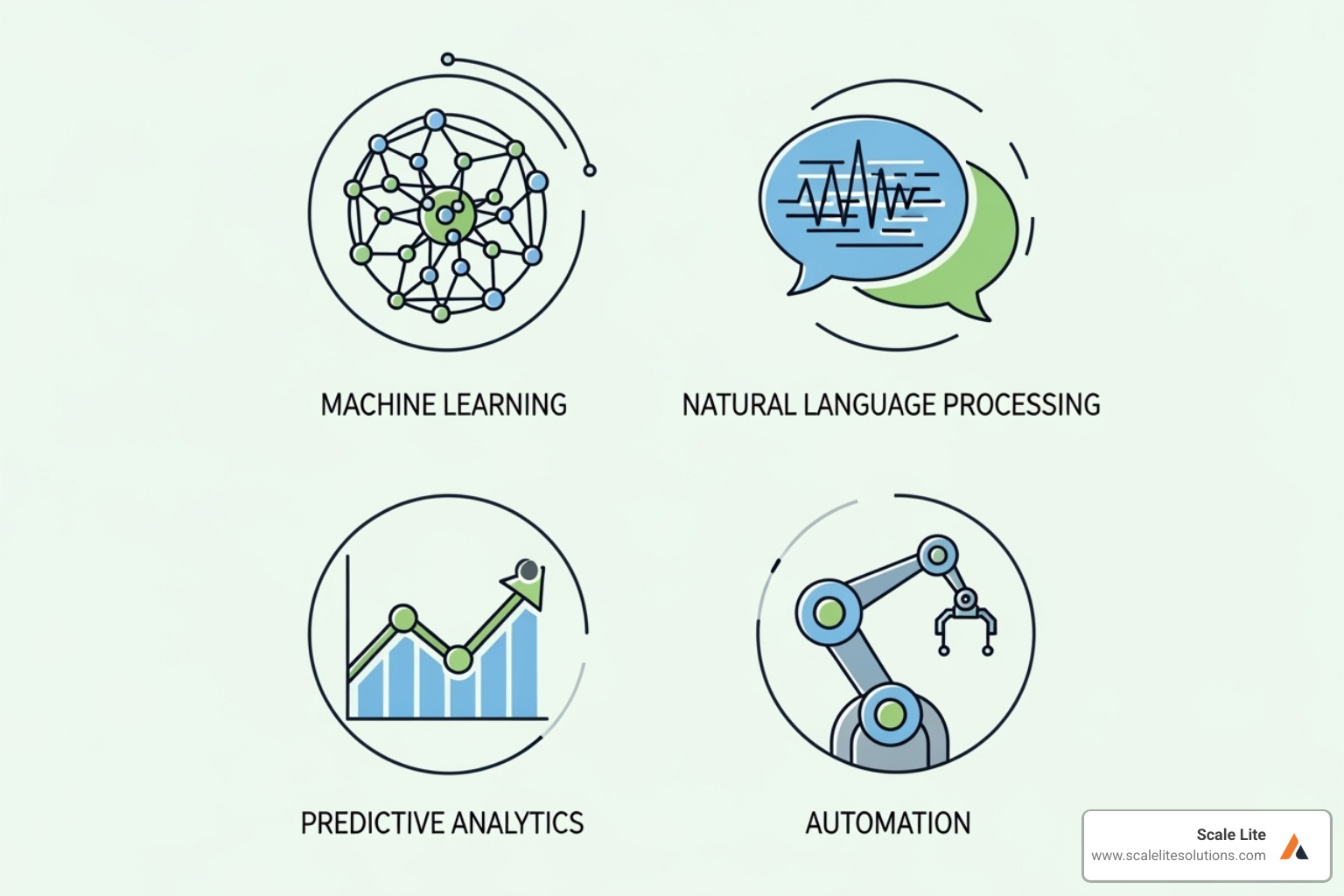
Machine Learning is like having an employee who gets smarter every day. It analyzes your past jobs, weather patterns, and traffic data to figure out the perfect schedule for your technicians. The more data it sees, the better its recommendations become. Think of it as your operations getting a brain upgrade that never stops learning.
Natural Language Processing turns your computers into great communicators. This technology understands what your customers are really asking when they call or email. It can draft responses, analyze feedback, and even spot trends in complaints before they become bigger problems. JPMorgan Chase uses this kind of system to review loan agreements – work that used to take lawyers 360,000 hours now happens in seconds.
Computer Vision gives your business superhuman eyes. It can spot defects your quality team might miss, monitor safety on job sites, and track inventory without anyone lifting a clipboard. One manufacturer boosted their defect detection by 90% and cut quality control costs in half just by letting AI do the looking.
Robotic Process Automation is your digital workforce that never calls in sick. These software bots handle the boring stuff – data entry, invoice processing, report generation – faster and more accurately than any human. Telefónica O2 uses 160 of these digital workers to handle hundreds of thousands of transactions monthly, freeing up their human team for work that actually requires creativity and problem-solving.
From Data to Decisions: The AI Advantage
Your business generates tons of data every day, but without AI, making sense of it all feels like trying to drink from a fire hose. That's where AI driven efficiency becomes your competitive advantage.
AI transforms all that messy data into crystal-clear insights through real-time analytics that show you exactly what's happening in your business right now. It uses predictive capabilities to tell you what's likely to happen next week or next month. Most importantly, its pattern recognition spots opportunities and problems that would be invisible to even your most experienced team members.
This shift from guessing to knowing changes everything. Instead of reacting to problems after they happen, you can prevent them entirely. AI helps you make data-driven decisions faster and with more confidence, whether you're deciding when to order supplies, which jobs to prioritize, or how to deploy your team for maximum impact.
The real magic happens when AI turns your raw operational data into actionable strategies. It's like having a crystal ball that actually works, helping you make smarter choices that drive real results for your business.
How AI Boosts Your Daily Operations
When you step back and look at your business operations, there's probably a mix of tasks that run smoothly and others that feel like constant headaches. The beauty of AI driven efficiency lies in how it transforms those problem areas into your competitive advantages.
By integrating AI thoughtfully into your daily operations, you're not just fixing what's broken – you're creating intelligent systems that get better over time. Think of it like upgrading from a basic toolbox to a smart workshop that anticipates what you need before you even ask for it.
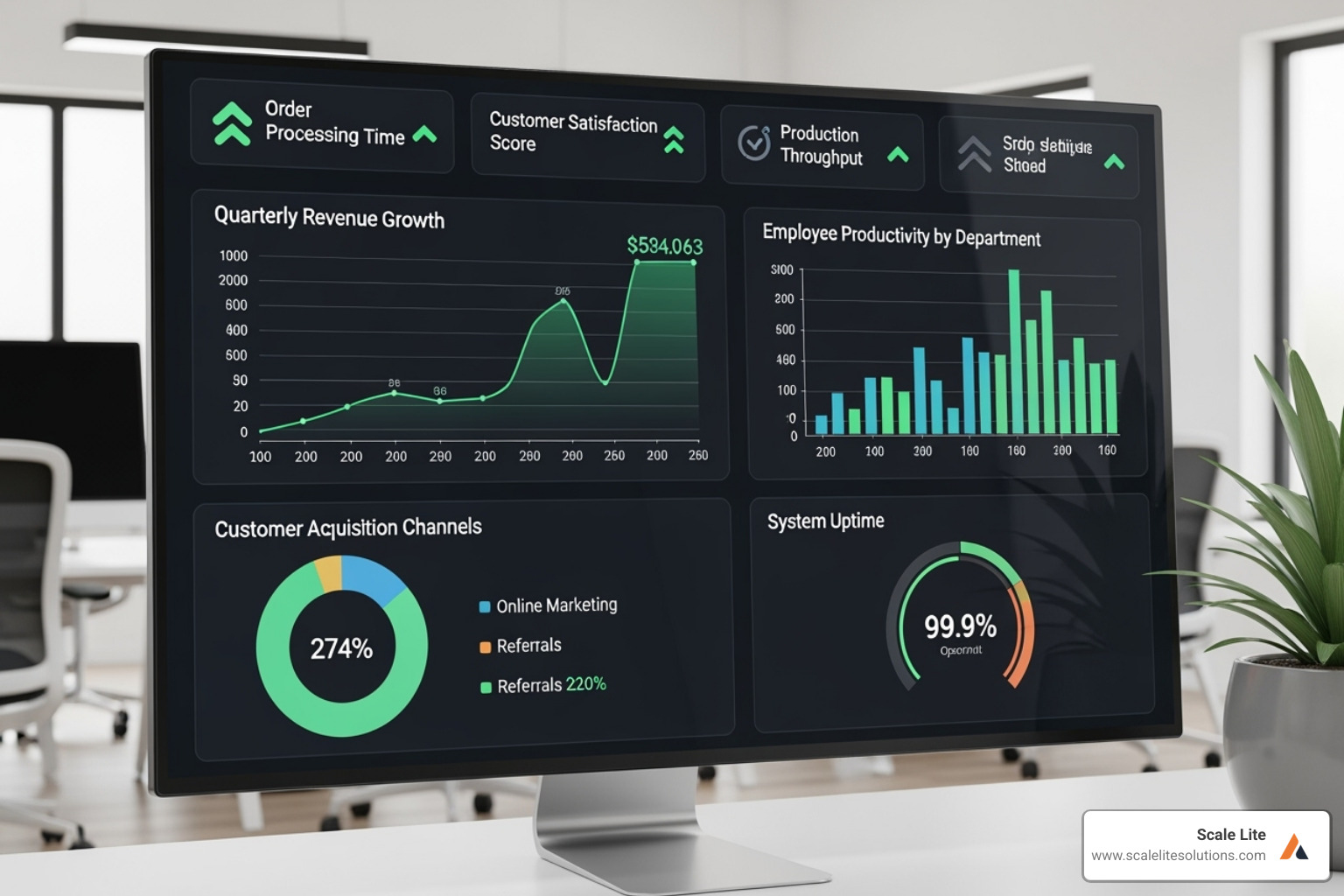
Automating Workflows to Free Up Your Team
Let's talk about those tasks that make your team groan – you know, the endless invoicing, data entry, and scheduling that somehow always takes longer than it should. These repetitive tasks are where AI truly shines, and frankly, where your team will thank you most.
AI driven efficiency starts with identifying these time-drains and turning them into automated processes. AI bots can zip through invoicing in minutes instead of hours, update customer records without a single typo, and coordinate schedules across multiple team members without the usual back-and-forth emails.
Here's what makes this exciting: when your skilled technicians or customer service reps aren't buried in paperwork, they can focus on what they do best. That means more time for strategic work, complex problem-solving, and building relationships with customers. The MIT Sloan School research we mentioned earlier shows this shift can boost employee performance by up to 40% – and that's not just about speed, it's about job satisfaction too.
Our AI-Driven Workflow Automation solutions are designed specifically for businesses like yours. We help identify which processes are ready for automation and implement systems that allow your team to focus on the work that actually grows your business.
Optimizing Your Supply Chain and Inventory
If you've ever found yourself with a warehouse full of parts you don't need or scrambling to find supplies for an urgent job, you understand the supply chain struggle. It's like trying to predict the weather – sometimes you get it right, sometimes you get caught in the rain.
AI changes this guessing game into a science. Through demand forecasting, AI analyzes your historical sales, seasonal patterns, and even external factors like local construction booms or economic shifts. Instead of ordering based on gut feeling, you're making decisions backed by data that considers dozens of variables you might not even think about.
The results speak for themselves. Companies using AI for inventory management typically see stockouts drop by 30% while reducing inventory costs by 15%. That's money staying in your pocket instead of sitting on shelves.
But AI driven efficiency goes beyond just knowing what to order. It optimizes your warehouse operations by suggesting better layouts for faster picking and packing. It provides predictive maintenance alerts that catch equipment problems before they shut down your operations – imagine knowing your delivery truck needs attention next week instead of finding out when it breaks down on a job site.
Supplier management becomes smarter too. AI can evaluate your vendors' performance, predict potential disruptions, and even recommend alternatives when your regular supplier hits a snag. One airline reduced maintenance-related flight delays by 30% using AI-driven predictive maintenance – that's the kind of reliability that builds customer trust.
Revolutionizing Customer Service and Engagement
Customers expect answers fast. Really fast. If you're in a service business, you probably know that contractors who respond to inquiries within five minutes are 400% more likely to win the job. That's a game-changing statistic, but it's also a lot of pressure on your team.
This is where AI chatbots and 24/7 support become your secret weapon. These aren't the clunky, frustrating bots from a few years ago – modern AI can handle real conversations and provide genuinely helpful responses. A telecom company found their AI chatbot could handle 70% of routine customer inquiries automatically, which freed up their human team for the complex issues that really needed personal attention.
What's particularly powerful is how AI creates personalized interactions. Instead of treating every customer the same way, AI analyzes their history, preferences, and current needs to tailor responses. It's like having a team member who remembers every detail about every customer, all the time.
The reduced call volume means your human customer service team isn't overwhelmed with routine questions about business hours or basic service information. Instead, they can focus on building relationships, solving complex problems, and turning satisfied customers into loyal advocates for your business.
This change in customer service isn't just about efficiency – it's about creating the kind of responsive, professional experience that sets you apart from competitors who are still playing phone tag with their customers.
A Practical Guide to Implementing AI for Efficiency
The thought of bringing AI into your business might feel overwhelming, but here's the truth: AI driven efficiency doesn't require a complete business overhaul overnight. Think of it more like renovating your home room by room, rather than tearing down the whole house and starting from scratch.
The smartest approach is strategic and step-by-step, where each small win builds momentum for the next phase. This way, you can see real results quickly while learning what works best for your specific business.
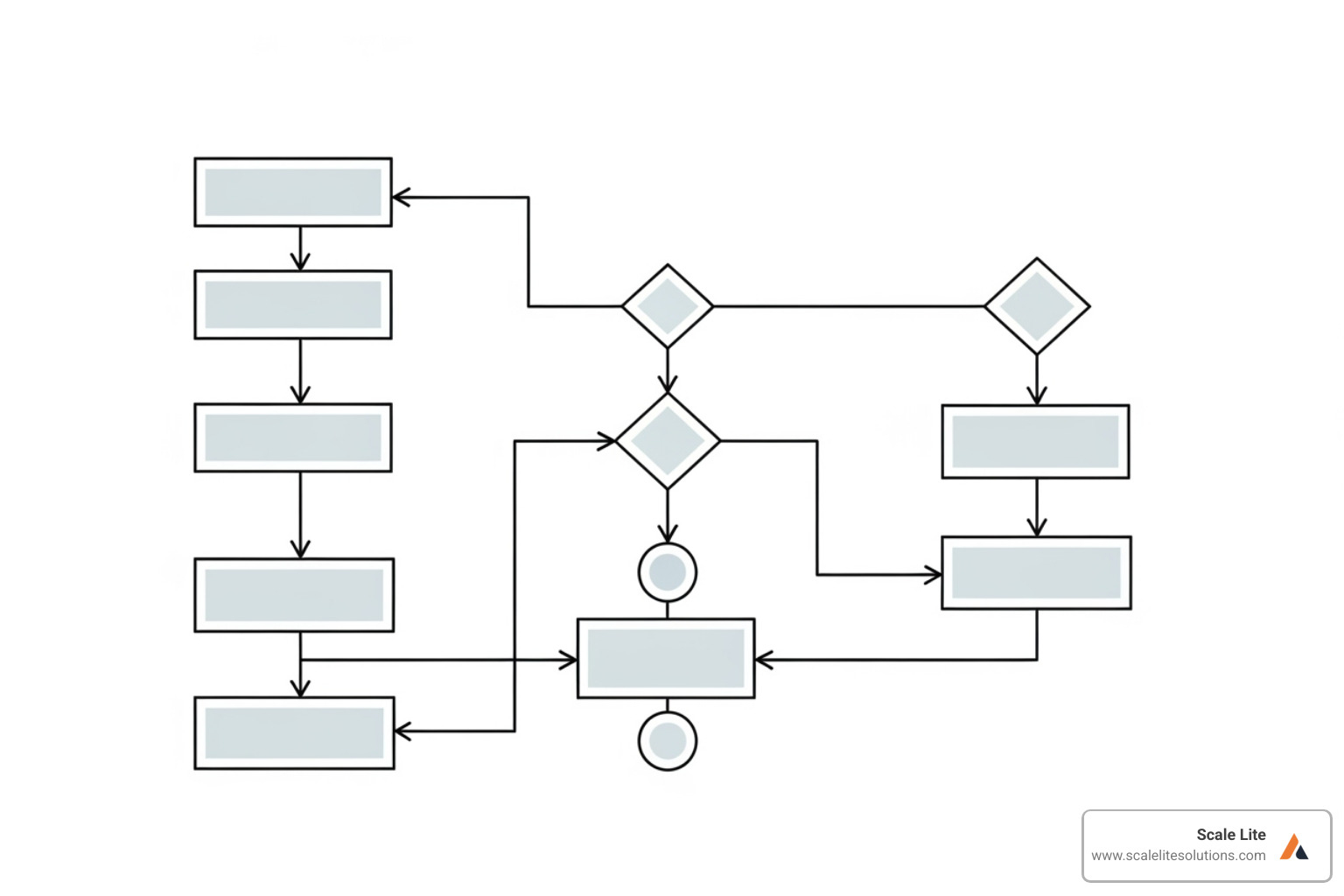
The journey typically starts with identifying your biggest bottlenecks - those daily frustrations that slow everything down. Maybe it's scheduling appointments, chasing invoices, or answering the same customer questions over and over. Once you spot these pain points, you can start small with one focused solution rather than trying to automate everything at once.
Next comes choosing the right tools for your specific needs and budget. This is where having a clear goal makes all the difference - you're not just buying technology, you're solving a specific problem. Then it's about training your team so they feel confident and excited about their new AI-powered workflows. Finally, you measure and refine based on real results, making adjustments as you learn what works best.
Overcoming Common Challenges
Let's be honest - implementing AI isn't always smooth sailing. But knowing what challenges to expect makes them much easier to handle. Most businesses run into similar roadblocks, and the good news is they're all solvable with the right approach.
Data quality is often the first hurdle. AI systems are like really smart employees - they can only work with what you give them. If your data is scattered across different systems, incomplete, or inconsistent, your AI will struggle to deliver meaningful results. The solution starts with getting your data house in order. This might mean cleaning up customer records, standardizing how information gets entered, or bringing data from different systems together in one place.
System integration presents another common challenge, especially for established businesses running on older software. Your existing systems weren't designed with AI in mind, but that doesn't mean they can't work together. Often, the solution involves using bridges (called APIs) that help different systems talk to each other, rather than replacing everything you already have.
The biggest challenge, though, is usually change management - helping your team accept new ways of working. It's natural for employees to feel nervous about AI. They might worry about job security or feel overwhelmed by new technology. The key is clear communication about how AI will make their jobs easier and more interesting, not replace them. When people understand that AI handles the boring, repetitive stuff so they can focus on problem-solving and customer relationships, resistance usually turns into enthusiasm.
Our Digital Change Strategies for Small Businesses approach focuses on starting with a clear goal, ensuring your data is clean, and communicating the benefits to your team to foster adoption.
Strategies for Small Businesses vs. Large Enterprises
The path to AI driven efficiency looks different depending on your business size, and that's actually good news - you can choose the approach that fits your reality.
Small businesses and startups have a unique advantage: they can build AI into their operations from day one. Without legacy systems to work around, smaller companies can often move faster and be more flexible. You might start with AI chatbots to handle customer inquiries, use automated scheduling systems, or implement smart inventory management. The beauty is that you can grow into more sophisticated AI as your business scales.
Startups today are achieving remarkable efficiency gains. Some AI-native companies are operating with just 20-50 employees while generating millions in revenue - something that would have required hundreds of people just a decade ago. This isn't about replacing human creativity and relationships; it's about eliminating the time-consuming administrative work that keeps you from focusing on growth. Our SME Business Change services help smaller businesses leverage AI for rapid and Scalable Business Solutions.
Larger, established businesses typically take a more methodical approach. Rather than rebuilding everything, they focus on optimizing specific high-impact areas first. This might mean starting with customer service automation, supply chain optimization, or financial reporting. The key is choosing projects with clear, measurable benefits that can demonstrate value to stakeholders.
Established companies often have more complex needs but also more resources to invest in comprehensive solutions. They might implement AI gradually across different departments, allowing each area to adapt at its own pace while maintaining business continuity.
Mitigating Bias and Ensuring Ethical AI Use
As powerful as AI can be, it learns from the data and examples we provide. If those examples contain biases - even unintentional ones - the AI might perpetuate them. This is especially critical in areas like hiring, customer service, or financial decisions.
Fairness starts with the data you feed your AI systems. If historical hiring data shows bias toward certain groups, an AI trained on that data might continue those patterns. The solution is to audit your training data before implementing AI, looking for and correcting these issues upfront.
Transparency means understanding how your AI makes decisions. Instead of treating AI as a mysterious black box, choose systems that can explain their reasoning. For example, if an AI system recommends a particular course of action, you should be able to understand why it made that choice. This builds trust and makes it easier to spot potential problems.
Accountability involves regular check-ins on your AI systems. Just like you'd review employee performance, you need to monitor AI outputs for fairness and accuracy. This includes setting up processes to address concerns when they arise and making adjustments as needed.
The goal isn't to create perfect systems - that's impossible. Instead, it's about building AI that's fair, transparent, and continuously improving. When customers, employees, and partners trust your AI systems, they become powerful tools for building stronger business relationships and better outcomes for everyone involved.
Frequently Asked Questions about AI-Driven Efficiency
Let's address the most common questions we hear from business owners who are considering AI implementation. These are real concerns from real business owners, and they deserve honest, straightforward answers.
How does AI improve operational efficiency in a service business?
AI driven efficiency transforms service businesses by tackling the daily frustrations that eat up your time and energy. Think about those administrative tasks that seem to multiply overnight - scheduling appointments, managing customer databases, and processing invoices. AI handles these automatically, freeing your team from the paperwork pile.
For field service businesses, the impact is even more dramatic. AI can optimize routing for technicians, cutting travel time and fuel costs significantly. Instead of your dispatcher spending hours figuring out the best routes, AI does it in seconds, considering traffic patterns, job priorities, and technician skills.
Customer service gets a major upgrade too. AI-powered chatbots provide instant answers to common questions 24/7, which means your customers get help immediately while reducing the load on your phone lines. One of our clients saw their call volume drop by 40% after implementing a smart chatbot system.
Perhaps most importantly, AI can predict maintenance needs for your equipment. Instead of dealing with unexpected breakdowns that cost you time and money, you get early warnings that let you schedule repairs during slow periods. This proactive approach helps to Improve Business Operations by preventing costly downtime before it happens.
What is the first step to implementing AI in my company?
Here's the honest truth: don't try to automate everything at once. That's a recipe for frustration and wasted money. The best first step is identifying the single biggest bottleneck or most time-consuming repetitive task in your current workflow.
Maybe your customer service team is drowning in the same questions over and over - that's perfect for a chatbot. Or perhaps your office manager spends hours every week on data entry - that's where Robotic Process Automation shines. The key is picking one small, high-impact project with clear, measurable outcomes.
Starting small gives you several advantages. You can demonstrate value quickly, which gets your team excited about AI instead of worried about it. You'll learn the implementation process without risking major disruptions. And you'll build internal confidence that makes scaling up to more complex AI initiatives much smoother.
Think of it like learning to drive - you don't start on the highway. You begin in an empty parking lot, master the basics, then gradually take on more challenging roads.
Will AI replace my employees?
This question keeps many business owners up at night, and I completely understand why. But here's the reality: AI driven efficiency isn't about replacing your valuable team members - it's about making them more valuable.
When AI handles the mundane, repetitive tasks, your employees get to focus on the work that requires uniquely human skills like creativity, critical thinking, problem-solving, and building relationships with customers. Your sales team stops drowning in data entry and spends more time actually selling. Your technicians focus on complex repairs instead of paperwork.
Consider this real example: one of our clients implemented AI for their HR administrative tasks. Instead of eliminating the HR position, it freed up their HR manager to focus on employee development and engagement. The result? Higher employee satisfaction, better retention, and a more productive workplace.
The goal is change, not elimination. AI helps to How to Improve Employee Productivity by removing the boring stuff so your team can do the meaningful work that drives your business forward. It's about working smarter, together - not working alone.
Conclusion: Your Edge in a Competitive Market
The change is happening whether we're ready or not. Companies that accept AI driven efficiency today will be the ones setting the pace tomorrow, while those who wait will find themselves scrambling to catch up.
Throughout this guide, we've explored how AI can revolutionize every corner of your business operations. From automating those tedious workflows that eat up your team's valuable time to optimizing supply chains with predictive precision, AI isn't just changing how we work—it's redefining what's possible for businesses like yours.
Think about it: AI can handle 70% of routine customer inquiries automatically, predict equipment failures before they cause costly downtime, and boost employee performance by up to 40%. These aren't pie-in-the-sky promises; they're real results that businesses are achieving right now.
But here's what makes this especially exciting for service businesses and companies in traditional industries—you don't need to be a tech giant to harness this power. The tools are accessible, the strategies are proven, and the competitive advantage is there for the taking.
AI driven efficiency offers you the chance to reduce operational costs, delight customers with faster service, and build a business that's not just surviving but thriving in an increasingly competitive market. Your team gets to focus on the work that truly matters—the creative problem-solving, the relationship building, the strategic thinking that only humans can do.
The journey to AI-powered operations might seem daunting, but you don't have to steer it alone. At Scale Lite Solutions, we've made it our mission to help blue-collar service businesses and low-tech industries harness the power of modern technology. We understand your unique challenges because we've been there with dozens of companies just like yours.
We take the complexity out of AI implementation, providing you with custom strategies that fit your business, your budget, and your timeline. From identifying the right starting point to training your team and measuring success, we're with you every step of the way.
Ready to transform your operations and gain that crucial competitive edge? The future of your business starts with a single decision to accept change. Explore our Digital Change Services to find how we can help you open up your business's full potential and build the efficient, scalable operation you've always envisioned.




